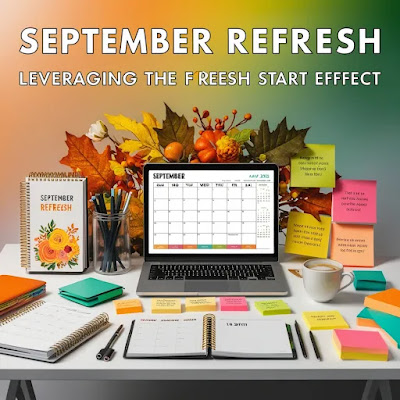Time Management Hacks for September: Leveraging the Fresh Start Effect
Time Management Hacks for September: Leveraging the Fresh Start Effect
Introduction
September is more than just the start of fall—it's a time of renewal, often referred to as the "second New Year." As summer fades, many of us experience a burst of motivation to reset our goals and routines. This period, known as the "Fresh Start Effect," is a powerful psychological phenomenon that can be harnessed to optimize your time management strategies. In this article, we will explore practical, research-backed time management hacks that can help you make the most of this September.
1. Quick Morning Routines: The Foundation of a Productive Day
Why It Matters:
Mornings set the tone for the entire day. A well-structured morning routine can significantly enhance productivity and mental clarity. According to the American Psychological Association, consistent morning routines increase the likelihood of achieving daily goals by 70%.
How to Implement:
- Simplify Your Routine: Focus on key activities that prepare you for the day. Starting with a 10-minute meditation session can reduce stress by 20%, according to a study by UCLA.
- Hydrate and Nourish: Kickstart your metabolism with a glass of water and a nutritious breakfast.
- Minimize Decisions: Plan your outfit and meals the night before to reduce decision fatigue. Mark Zuckerberg, for example, adheres to a simple wardrobe to conserve mental energy for critical decisions.
Example: Incorporating a brief mindfulness exercise into your morning routine can enhance focus and reduce stress, laying the groundwork for a productive day.
2. Prioritize Like a Pro: The Art of Effective Task Management
Why It Matters:
Not all tasks are created equal. Effective prioritization ensures that your most important tasks get done first. The Pareto Principle (80/20 rule) states that 80% of your results come from 20% of your efforts.
How to Implement:
- Identify High-Impact Tasks: Use tools like the Eisenhower Matrix to categorize tasks based on urgency and importance.
- Time Blocking: Allocate specific time slots to focus solely on high-priority tasks, free from interruptions. Research indicates that time blocking can boost productivity by up to 150% [5].
Example: Jeff Bezos prioritizes critical tasks early in the day, aligning them with his peak energy levels. This strategy ensures that important decisions are made when he is at his best.
3. Time Blocking for Maximum Efficiency
Why It Matters:
Multitasking is a myth. The brain is wired to focus on one task at a time. Time blocking allows you to concentrate on a single task, reducing distractions and increasing productivity.
How to Implement:
- Create Dedicated Time Blocks: Set aside specific periods for different types of work—deep focus, meetings, administrative tasks—ensuring each gets the attention it deserves.
- Batch Similar Tasks: Group similar tasks, such as emails or meetings, to maintain focus and avoid the inefficiency of constant task-switching.
Statistical Support: Harvard Business Review reports that time blocking can reduce task-switching by 60%, leading to significant productivity gains.
4. Leverage Digital Tools for Enhanced Productivity
Why It Matters:
In the digital age, numerous tools can help you manage your time more effectively. From project management software to apps designed to boost focus, these tools streamline your workflow and improve efficiency.
How to Implement:
- Task Management Tools: Platforms like Trello, Asana, or Monday.com organize tasks, set deadlines, and facilitate collaboration, centralizing your work and reducing time spent on planning and organizing.
- Focus Enhancement Apps: Apps like Focus@Will or Brain.fm use specially designed music to boost concentration by up to 400%.
Example: Google Calendar’s AI-driven scheduling feature can automatically adjust your calendar based on your priorities and availability, optimizing your daily routine.
5. Plan Your Downtime: The Power of Rest
Why It Matters:
Continuous work without breaks can lead to burnout, reducing overall productivity. Scheduling regular breaks refreshes your mind, reduces stress, and helps maintain efficiency.
How to Implement:
- Schedule Short Breaks: The Pomodoro Technique, involving 25 minutes of work followed by a 5-minute break, improves focus and productivity.
- Engage in Relaxing Activities: Use breaks for relaxing activities like walking, stretching, or reading.
Statistical Support: The University of Illinois found that regular breaks can increase productivity by up to 25%, allowing the brain to rest and recover before tackling the next task.
6. Weekly Review and Adjustments: Reflect and Refine
Why It Matters:
Regular reflection on your progress keeps you aligned with your goals. A weekly review allows you to assess what worked, what didn’t, and how to adjust your approach for the upcoming week.
How to Implement:
- Reflect on the Past Week: Set aside time each Sunday to review your achievements and challenges from the previous week.
- Set Goals for the Next Week: Based on your review, set clear, actionable goals for the coming week.
Example: Entrepreneurs like Elon Musk dedicate time each week to review their progress, ensuring alignment with long-term goals.
7. Embrace the Power of Small Changes
Why It Matters:
Major transformations often begin with small, consistent changes. Implementing even one or two of the time management hacks discussed in this article can lead to noticeable improvements in your productivity and well-being.
How to Implement:
- Start with One Change: Focus on integrating one new habit into your routine, such as time blocking or simplifying your morning routine. Once it becomes a habit, move on to the next hack.
- Track Your Progress: Use a habit tracker to monitor your consistency and the impact of these changes on your productivity.
Statistical Support: The British Journal of Health Psychology highlights that small behavioral changes, when practiced consistently, can result in long-term improvements in productivity and life satisfaction.
Conclusion
September is the perfect time to implement these time management hacks and take control of your productivity. By making small but impactful changes to your routine, you can achieve more, reduce stress, and find a better balance in your daily life. The key to success lies in consistency and adaptability. Start small, stay committed, and watch as these changes transform your efficiency.
Want more tips on optimizing your life for the fall season? Check out our detailed guide on adjusting personal routines to seasonal changes here.
FAQ
Q1: How can I implement these time management hacks if I have a busy schedule?
A1: Start small by focusing on just one hack, like simplifying your morning routine or implementing time blocking. Gradually introduce more as you become comfortable.
Q2: Are these strategies effective for remote workers?
A2: Absolutely. Time blocking and digital tools, in particular, can be highly effective for remote workers who need to manage their time independently and stay productive.
Q3: How long will it take to see results?
A3: While individual results vary, many people start noticing improvements in productivity within a week of consistent application.
Q4: Can these strategies help with work-life balance?
A4: Yes, by effectively managing your work time, you can create more space for personal activities, reducing stress and improving your overall well-being.
Q5: Is it necessary to use all these hacks at once?
A5: No, start with one or two that resonate most with you and gradually add more as you become accustomed to the changes.






